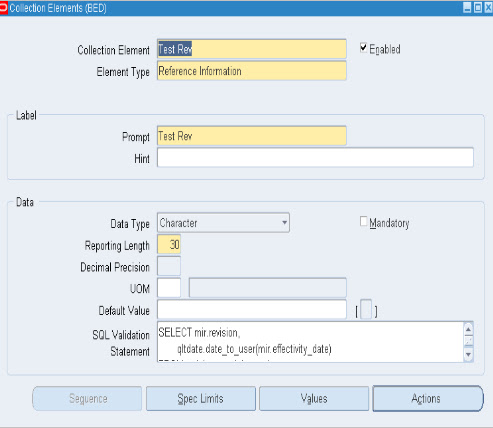
* Replenishment Counts
2) MTL_TXN_REQUEST_LINES: Move order lines, this is the one that drives most queries and status checks for the move order as each line can be transacted individually.
3) MTL_MATERIAL_TRANSACTIONS_TEMP: Pending material transactions table also called the transaction temporary table, this holds allocations that act like reservations on inventory. An allocation is where you pick a specific item in inventory down to the lot, locator, serial, revision to move, but you do not actually perform the move yet.
4) MTL_MATERIAL_TRANSACTIONS : Finally the Material Transactions will get into this table.
x_msg_data VARCHAR2 (4000);
x_msg_count NUMBER;
l_user_id NUMBER;
l_resp_id NUMBER;
l_appl_id NUMBER;
l_hdr_rec inv_move_order_pub.trohdr_rec_type:= inv_move_order_pub.g_miss_trohdr_rec;
x_hdr_rec inv_move_order_pub.trohdr_rec_type:= inv_move_order_pub.g_miss_trohdr_rec;
l_line_tbl inv_move_order_pub.trolin_tbl_type:= inv_move_order_pub.g_miss_trolin_tbl;
x_line_tbl inv_move_order_pub.trolin_tbl_type:= inv_move_order_pub.g_miss_trolin_tbl;
x_hdr_val_rec inv_move_order_pub.trohdr_val_rec_type;
x_line_val_tbl inv_move_order_pub.trolin_val_tbl_type;
v_msg_index_out NUMBER;
l_rsr_type inv_reservation_global.mtl_reservation_tbl_type;
l_code_combination_id gl_code_combinations.code_combination_id%type;
a.inventory_item_id,b.concatenated_segments,
a.subinventory_code,a.lot_number,
SUM (a.primary_transaction_quantity) total_onhand
FROM mtl_onhand_quantities_detail a,
mtl_system_items_kfv b,
org_organization_definitions c,
mtl_lot_numbers d
WHERE a.inventory_item_id = b.inventory_item_id
AND a.lot_number = d.lot_number
AND a.inventory_item_id = d.inventory_item_id
AND a.organization_id = b.organization_id
AND a.organization_id = c.organization_id
AND a.organization_id = d.organization_id
AND b.concatenated_segments = ‘RC0805FR-0768KL^YAGEO’
AND a.lot_number = ‘A6680983’
AND c.organization_code = ‘A66’
GROUP BY a.organization_id,c.operating_unit,
a.inventory_item_id, b.concatenated_segments,
a.subinventory_code, a.lot_number;
INTO l_user_id
FROM fnd_user
WHERE user_name = ‘A42485’;
INTO l_resp_id, l_appl_id
FROM fnd_responsibility_vl
WHERE responsibility_name = ‘Inventory’;
inv_globals.set_org_id (i.organization_id);
mo_global.init (‘INV’);
into l_code_combination_id
from gl_code_combinations_kfv
where concatenated_segments = ‘6420-00000-0000-999999-91000-0000-00000-0-0’;
x_line_tbl.DELETE;
l_hdr_rec.date_required := SYSDATE;
l_hdr_rec.header_status := inv_globals.g_to_status_preapproved;
l_hdr_rec.organization_id := i.organization_id;
l_hdr_rec.status_date := SYSDATE;
l_hdr_rec.transaction_type_id := inv_globals.g_type_transfer_order_issue;
l_hdr_rec.move_order_type := inv_globals.g_move_order_requisition;
l_hdr_rec.db_flag := fnd_api.g_true;
l_hdr_rec.operation := inv_globals.g_opr_create;
l_hdr_rec.description := ‘Test Move Order One’;
l_hdr_rec.to_account_id := l_code_combination_id;
l_hdr_rec.from_subinventory_code := i.subinventory_code;
l_line_tbl (1).date_required := SYSDATE;
l_line_tbl (1).inventory_item_id := i.inventory_item_id;
l_line_tbl (1).line_id := fnd_api.g_miss_num;
l_line_tbl (1).line_number := 1;
l_line_tbl (1).line_status := inv_globals.g_to_status_preapproved;
l_line_tbl (1).transaction_type_id := inv_globals.g_type_transfer_order_issue;
l_line_tbl (1).organization_id := i.organization_id;
l_line_tbl (1).quantity := 5000;
l_line_tbl (1).status_date := SYSDATE;
l_line_tbl (1).uom_code := ‘EA’;
l_line_tbl (1).db_flag := fnd_api.g_true;
l_line_tbl (1).operation := inv_globals.g_opr_create;
l_line_tbl (1).from_subinventory_code := i.subinventory_code;
l_line_tbl (1).to_account_id := l_code_combination_id;
l_line_tbl (1).lot_number := i.lot_number;
DBMS_OUTPUT.put_line (‘===================================’);
(p_api_version_number => 1.0,
p_init_msg_list => fnd_api.g_false,
p_return_values => fnd_api.g_false,
p_commit => fnd_api.g_false,
x_return_status => x_return_status,
x_msg_count => x_msg_count,
x_msg_data => x_msg_data,
p_trohdr_rec => l_hdr_rec,
p_trolin_tbl => l_line_tbl,
x_trohdr_rec => x_hdr_rec,
x_trohdr_val_rec => x_hdr_val_rec,
x_trolin_tbl => x_line_tbl,
x_trolin_val_tbl => x_line_val_tbl);
DBMS_OUTPUT.put_line (x_msg_count);
THEN
COMMIT;
DBMS_OUTPUT.put_line (‘Move Order Successfully Created’);
ROLLBACK;
DBMS_OUTPUT.put_line (‘Move Order Creation Failed Due to Following Reasons’);
END IF;
THEN
FOR v_index IN 1 .. x_msg_count
LOOP
fnd_msg_pub.get (p_msg_index => v_index,
p_encoded => ‘F’,
p_data => x_msg_data,
p_msg_index_out => v_msg_index_out
);
x_msg_data := SUBSTR (x_msg_data, 1, 200);
DBMS_OUTPUT.put_line (x_msg_data);
END IF;
END LOOP;
===================================
S
0
Move Order Successfully Created
Move Order Number is :=> 332557



Recent Comments